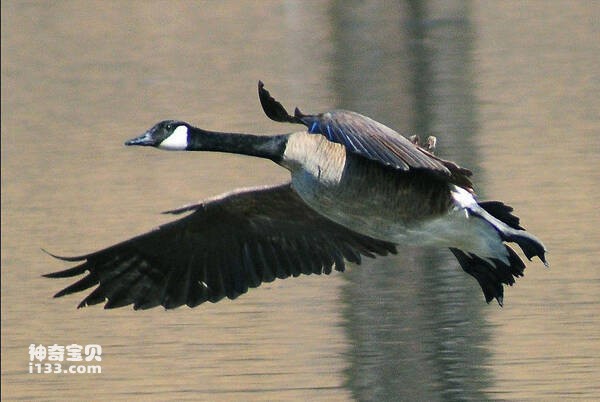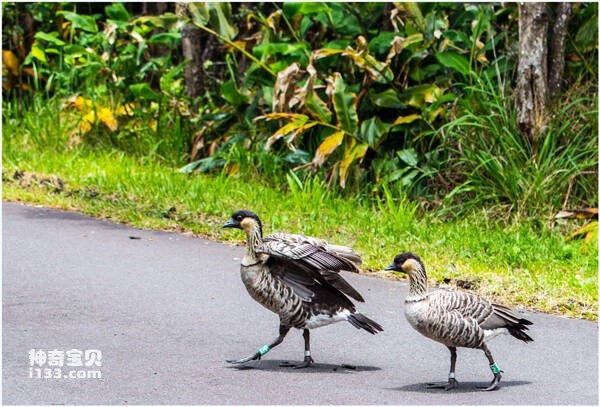Branta sandvicensis
IUCN
LCBasic Information
Scientific classification
- name:Branta sandvicensis
- Scientific Name:Branta sandvicensis,Hawaiian Goose
- Outline:Waterfowl
- Family:
Vital signs
- length:63-69cm
- Weight:1.5-3kg
- lifetime:No textual research information is available
Feature
It is related to the Canadian barnacle, a non-migratory land goose that evolved after the Canadian Barnacle migrated to Hawaii
Distribution and Habitat
The barnacle goose was once found on the islands of Hawaii, Kahulawai, Lanai, Molokai and Kauai. It is currently restricted to the islands of Hawaii, Maui, Molokai and Kauai.
It inhabits jungles, grasslands, sand dunes and lava plains. Artificial habitats include lawns and golf courses from sea level to 2,400 metres above sea level. Some groups have migrated to lowland and mountainous areas.
Appearance
Hawaiian barns are 63-69 cm long and weigh 1700-3000 g for males and 1500-2500 g for females. Adult male geese have a black head and nape, pale yellow cheeks, and distinct black and white stripes on the neck. The female goose is similar in color to the male bird. The beak and feet of the goose are black, with a narrow black ring at the base of the beak, soft hair on the chin, and dark brown irises. A pillow and degraded webbing on its toes allow the goose to traverse very rough terrain, such as lava fields. Young geese look like male geese, but they are dark brown, with no clear division between the head and neck, and their twill is not obvious.
Details
The wild Goose (Branta sandvicensis) is known as Hawaiian Goose without subspecies.

The typical wild goose is mostly distributed in the cold regions of the north and is a migratory bird, but the Hawaiian barnacle goose is an exception, staying in the tropical Hawaiian Islands. The Hawaiian barnacle goose is mainly distributed in the mountains of Hawaii Island, and its flippers have been degraded to a certain extent, which is suitable for walking in the mountains. The Hawaiian barnacle goose is a rare bird with a very limited distribution and was once on the verge of extinction.
They feed mainly on buds, leaves, stems, fruits, and flowers of grasses and aquatic plants, as well as roots and seeds.

The breeding time of Hawaiian barns is longer than that of any other wild goose, with the breeding season between August and April and the peak laying time between November and January, with about two to five eggs per nest. The female is responsible for site selection, nesting and brooding, and the nest is usually selected in the vegetation of the island. Incubation period is about 30 days; The male will be the lookout. Young geese can forage on their own after hatching, but remain unable to fly for up to three months and are particularly vulnerable to predation, living with their parents until the next breeding season.
The Hawaiian goose is a species of wild goose endemic to the islands of Hawaii. It is found on the islands of Maui, Kauai and Hawaii and is the state bird of Hawaii. Like birds on Hawaii and many other islands, its population declined dramatically after humans arrived. When Captain James Cook visited the island in 1778, there were about 25,000 Macadamia geese on the island. However, hunting and predation by exotic species, including meerkats, dogs and pigs, had reduced the population to just 30 by 1952.
Hawaiian geese grow well under artificial breeding conditions. In the first decade of the 21st century, captive Hawaiian geese were released into the wild. Their numbers are growing, but scientists are concerned that their gene pool is too homogeneous.
Listed on the IUCN Red List of Threatened Species (IUCN) ver 3.1:2021 - Near Threatened (NT).
Listed in Appendix I, Appendix II and Appendix III of the Convention on International Trade in Endangered Species of Wild Fauna and Flora (CITES) 2019 edition.
Protect wild animals and eliminate wild meat.
Maintaining ecological balance is everyone's responsibility!








